Disney’s California Misadventure
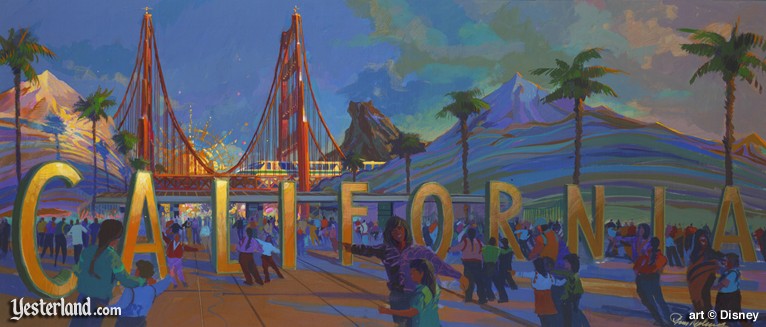
When Disney’s California Adventure opened in 2001, it had adapted many of the never-built elements of Disney’s America, overlaying the proposed Virginia park’s county fair, family farm, and white water rafting ride with Californian stories to become Paradise Pier, Bountiful Valley Farm, and Grizzly River Run, respectively.
However, you would’ve been hard-pressed to find anyone at Disney willing to call the park a success. In fact, far from it – both reception and attendence to California Adventure were pitifully below expectations. You’ll know why if you joined us on our walk through the opening day version of the park in Declassified Disasters: Disney’s California Adventure.
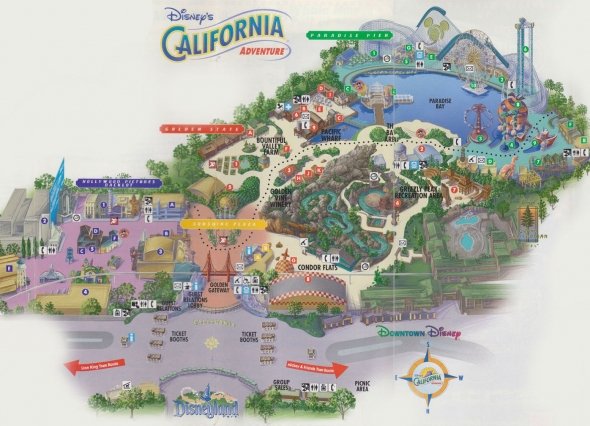
Financially starved (as were many projects in the era), the park was infamously short on rides, had practically nothing for kids, and featured almost no Disney characters. Its four (yes, just four) opening day “districts” included the barren Sunshine Plaza entry, the bland Hollywood Pictures Backlot (containing just one ride – the abysmal Declassified Disaster: Superstar Limo), Paradise Pier (littered with off-the-shelf carnival rides), and…
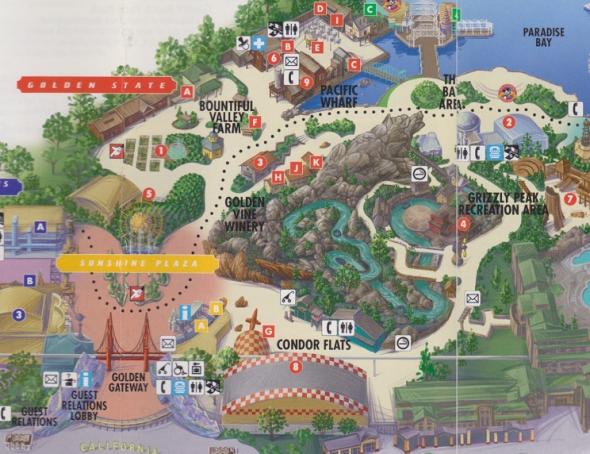
… The “all encompassing” Golden State. In fact, it’s that district that contained what might have been the park’s one, single, solitary success story. The Golden State was itself sub-divided into six (yes, six!) sub-areas. While Pacific Wharf, The Bay Area, Bountiful Valley Farm, and the Golden Vine Winery contained zero (zero!) rides between them, the other two – Grizzly Peak and Condor Flats – were different.
Condor Flats
When guests stepped into Condor Flats, they were meant to feel that they were walking along a runway strip on an airfield base littered with planes, engines, and rocket parts. Yep, it appears that Victory Field made the jump from Disney’s Virginian America to Disney’s California Adventure! (And in fact, if you look between the Victory Field concept art and the Passholder-exclusive Condor Flats concept art above, you’ll see that Disney artists essentially just redrew the former to create the latter!)
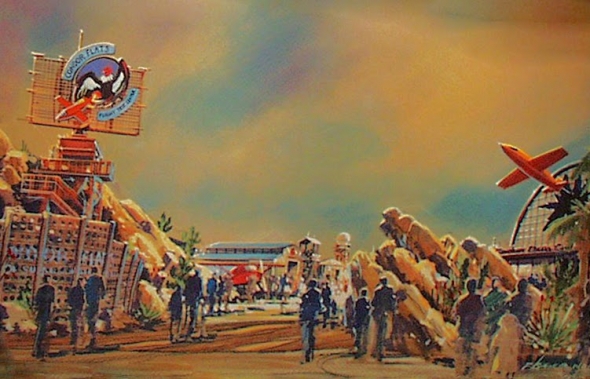
But in Condor Flats, the concept would drop its outright military connotation and instead become a “high desert” airfield, littered with red desert rocks and a sandy, dusty color scheme recalling remote landing strips that one might find in the Mojave Desert.
And like all of California Adventure’s opening day districts, it made sure to be “hip” and “edgy” with “MTV attitude.” Rather than taking us back to a revered and historic moment in Californian history, we’ve arrived at this rusty, run-down, unused aviation base with its scrap metal and old satellite dishes just as an enterprising group of young aviation enthusiasts have decided to make use of the hangars abandoned by the Lockheed Company decades ago.

In fact, the land’s official backstory announced that these young aviators had used the old, cavernous plane hangars to construct a “flying theater,” so anyone could witness the magic of flight! Now, first of all, this frustrating backstory falls into our surefire giveaways of a bad theme park story by casting guests as mere “tourists” in a “training facility” rather than letting us use our imaginations to maybe – just maybe! – believe we’re actually about to fly. (Don’t worry – this story was largely unpublished and mostly environmental, so it didn’t detract from the experience.)
Second of all, it takes the credit from the real Imagineer who made Soarin’ possible…
Pre-flight developments
It may be that Disney Imagineers’ development of the Soarin’ simulator took about as long as the Wright brothers’ path to flight. In fact, it was an idea that had been percolating at Disney for a while. When Epcot’s Lost Legend: Horizons closed (for the first time) in December 1994, plans for a Space pavilion were already top-of-mind… It just wasn’t the Space pavilion we know today.
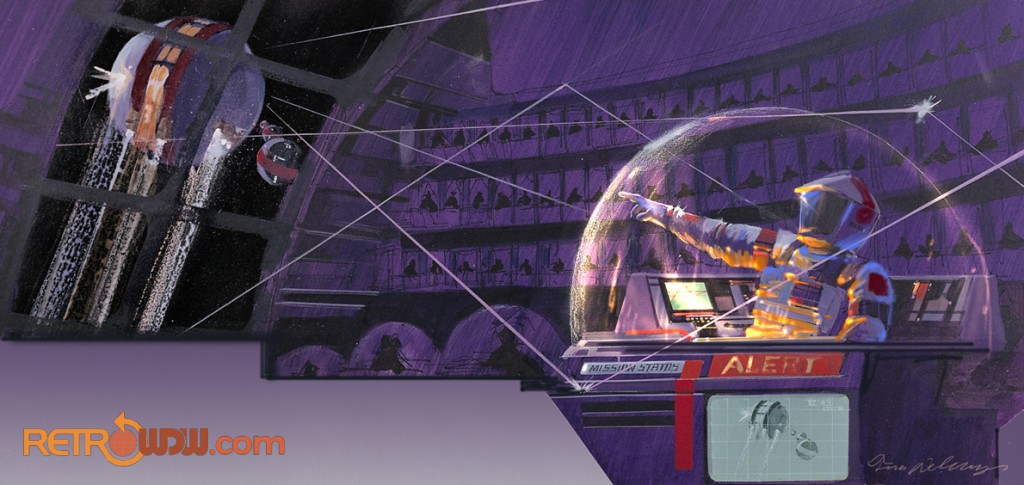
In fact, Imagineers initially envisioned a cutting edge attraction wherein guests would be loaded into three tiers of seats – stacked vertically – which would then be advanced forward, positioning guests inside a tilted OMNIMAX dome screen (see background, above).
This attraction would’ve provided guests with a spectacular journey through the stars, completely immersed in the wraparound projected world of outer space. But it had a problem.
Primarily, the build would be a massive undertaking. Though the rare Passholder-exclusive art above showing Horizons’ transformation is hugely exaggerated in its scale, it reveals the inherent issue with loading guests on three separate levels. to simultaneously load on three levels would require ramps, elevators, and escalators needed for guests to climb to their assigned level; careful timing and coordination; and (worst of all) Cast Members positioned on each floor to check restraints and monitor the ride.
In other words, the system would be huge, clunky, expensive to staff, and wildly inefficient.
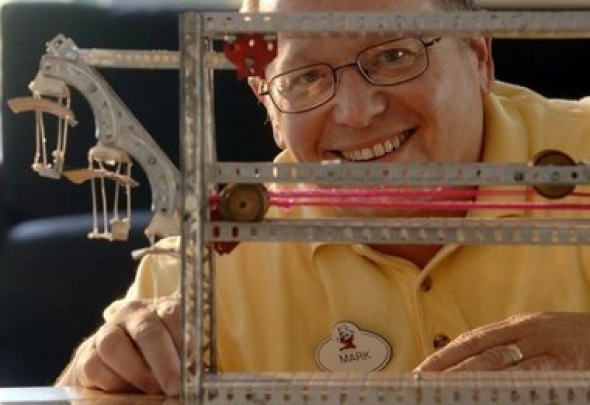
Enter the hero of our story. It was Imagineer Mark Sumner who cracked the case, famously using an old erector set to prepare a working, crank-operated model of a ride system where all guests would board on the same level before being swung out and lifted vertically to “stack” each row. In retrospect, the idea seems simple; even obvious. By hoisting three rows of visitors sky-high, they’d align vertically, “soaring” together inside of a lifted, tilted, curved OMNIMAX screen.
Granted, easier said than done.
As revealed in the ride system patent above, the million-pound steel apparatus lifts 87 riders at a time forty feet high in 37-ton gliders (weighing more than 120 of the Wright brothers’ planes). Once airborne, these seemingly delicate gliders park inside of an inverted OMNIMAX domed screen and subtly rise, lower, and pitch in sync with the ride film.
Just like that, Disney’s California Adventure would have its own headliner. Initially working under the title “Ultra Flight,” this new genre of simulator would do what no other had: it would focus not on speed, turbulence, or thrills, but on the grace, majesty, power, and serenity of flight. Ultra Flight would make its way across the Golden State, giving guests a glimpse of the natural and manmade wonders of California.
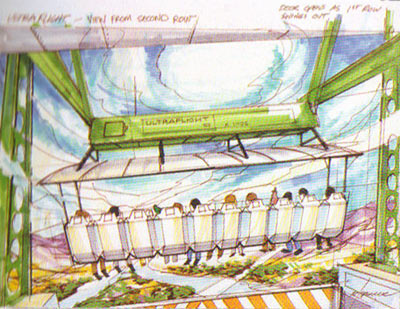
Speaking of which, even with the infrastructure designed, Disney still had work to do before anyone would care to fly on Ultra Flight.
Flight Path
The process of filming the stunning camerawork for the ride was certainly not as easy as it would seem. First, Disney needed special permission to film in some of the ride’s most sought-after scenes. Obtaining permissions to fly helicopters through Yosemite National Park took months of bureaucratic compliance, marking the first time in nearly half-a-century that a vehicle had taken to the skies there.
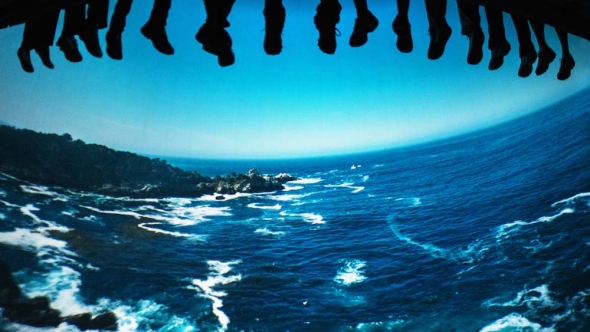
Since Monterey is a marine sanctuary, Disney worked for years to secure clearance. In the final shot, a National Oceanic and Atmospheric Administration boat would be visible in the water. Far from a staged shot, the NOAA representatives were on-site to ensure the safety of Monterey’s protected sea lions, brown pelicans, and sea otters during Disney’s filming.
A scene where riders would glide over the Anza-Borrego desert over a team of horses and equestrians required that Disney hire archaeologists to perform a paleontological assessment to ensure no artifacts would be disturbed by the horses or helicopter. Put another way: a research team had to dust four square miles of desert before filming could commence.
In that same scene over the desert, Disney would meet many times with the U.S. Air Force to coordinate a team of Thunderbird planes to jet through. Careful charting and arranging was necessary, since the Thunderbirds travel too fast to sense whether or not the helicopter was within their flight path. The jets travel so fast, Disney’s film crew took off in a helicopter a few miles from the scene while the Thunderbirds took off from Nellis Air Force Base near Las Vegas – nearly 200 miles away – at the same time to rendezvous at the filming location.
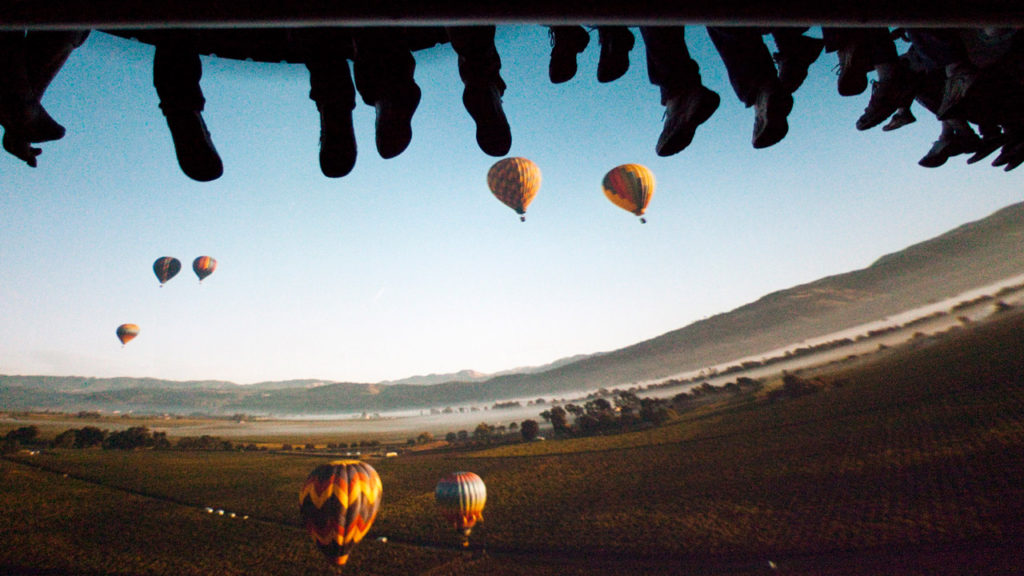
Another trick? Every human you’d spot during the ride (from skiers to surfers and everything in between) would be a plant, hired to add dynamic energy to the scene (while, of course, not looking at the camera-clad helicopter zooming by overhead). The rock climbers in Yosemite literally hung around for six hours, dangling from their climbing ropes between takes.
Finally, with the gorgeous vistas of California captured on IMAX film in 48-frames-per-second (twice the frame rate of typical films), Soarin’ Over California was nearing completion… But it was missing one integral ingredient.
Music to soar to…
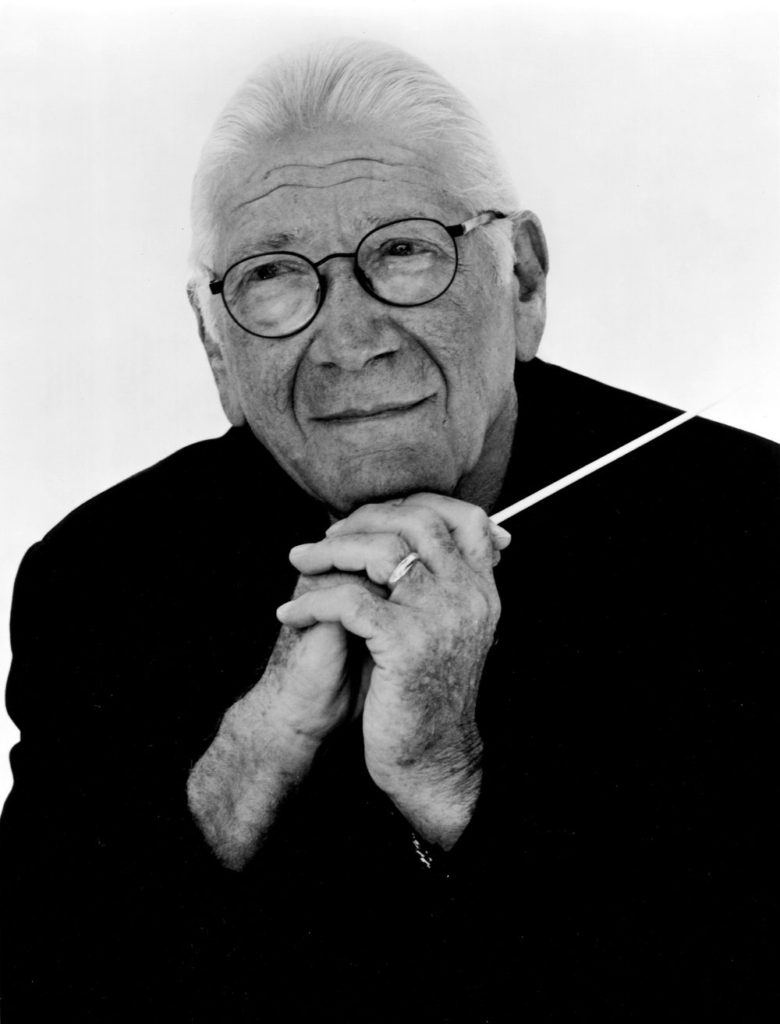
For Disney, no masterpiece attraction is complete without music. In this case, Disney approached composer Jerry Goldsmith, whose resume includes 1968’s Planet of the Apes, Alien, Poltergeist, Gremlins, five Star Trek films, The Mummy, and Disney’s own Mulan.
They’d picked the right person. Goldsmith was invited to Imagineering to get a test screening of the footage collected so far for Soarin’ Over California in a mock-up theater. As the story goes, when he descended at the end of the ride film, Imagineers were shocked to find him crying. Goldsmith reported that nothing had gone wrong on the ride. Rather, after more than four decades composing, he felt he had just stumbled upon his dream project, fusing his two loves: music and flight.
Especially given that he’d been born and raised in California with a father who was a pilot, Goldsmith apparently said, “I’d do anything to be part of this project. I’d even score the film for free.” For the record, Disney did pay him. But the resulting score has to be among the most moving pieces of composition in the Disney Parks songbook – an uplifting, powerful, majestic piece of music that perfectly underscores each progressive moment of the ride.
Soar
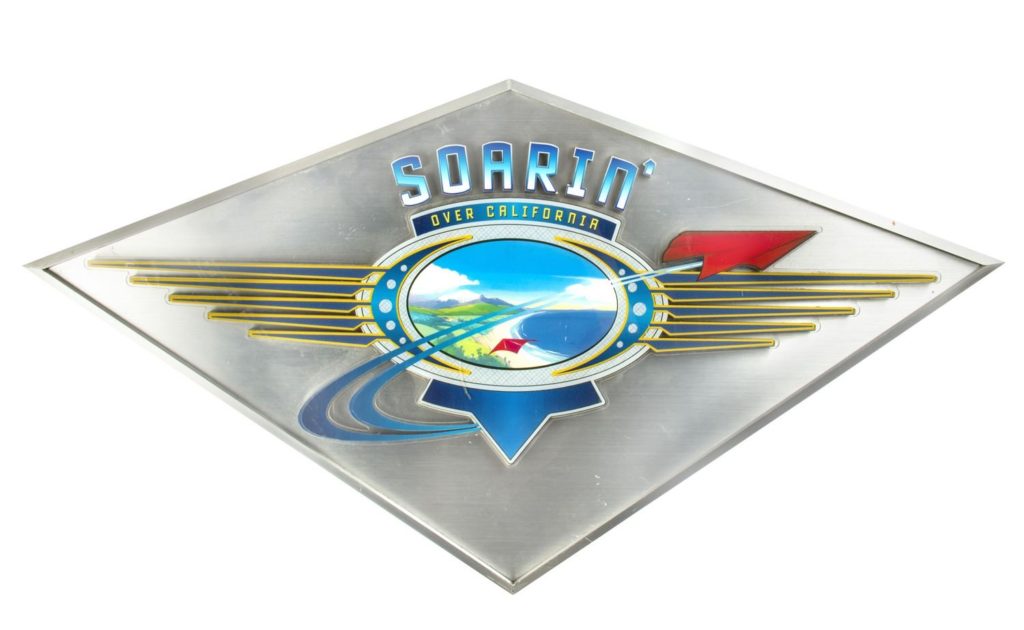
Disney Parks fans often talk about each park’s “thesis” attraction – the one, single ride that exemplifies the park’s principles and heart best. Without a doubt, this free-flying expedition would be California Adventure’s. A gorgeous masterpiece skillfully blending technology and artistry in the way only Disney can, Soarin’ Over California would be a headliner.
Soarin’ was ready for takeover. Are you? Read on…





